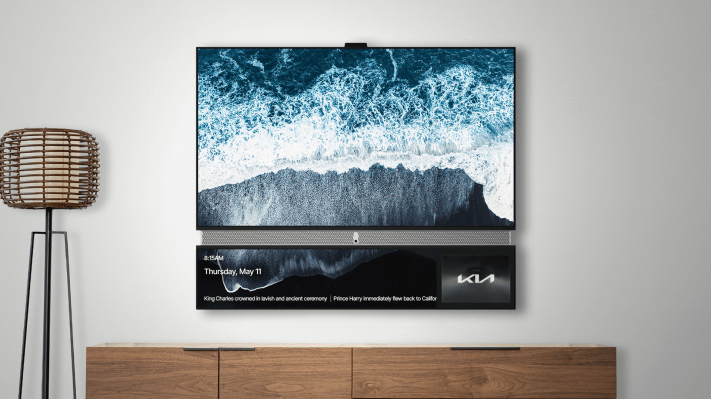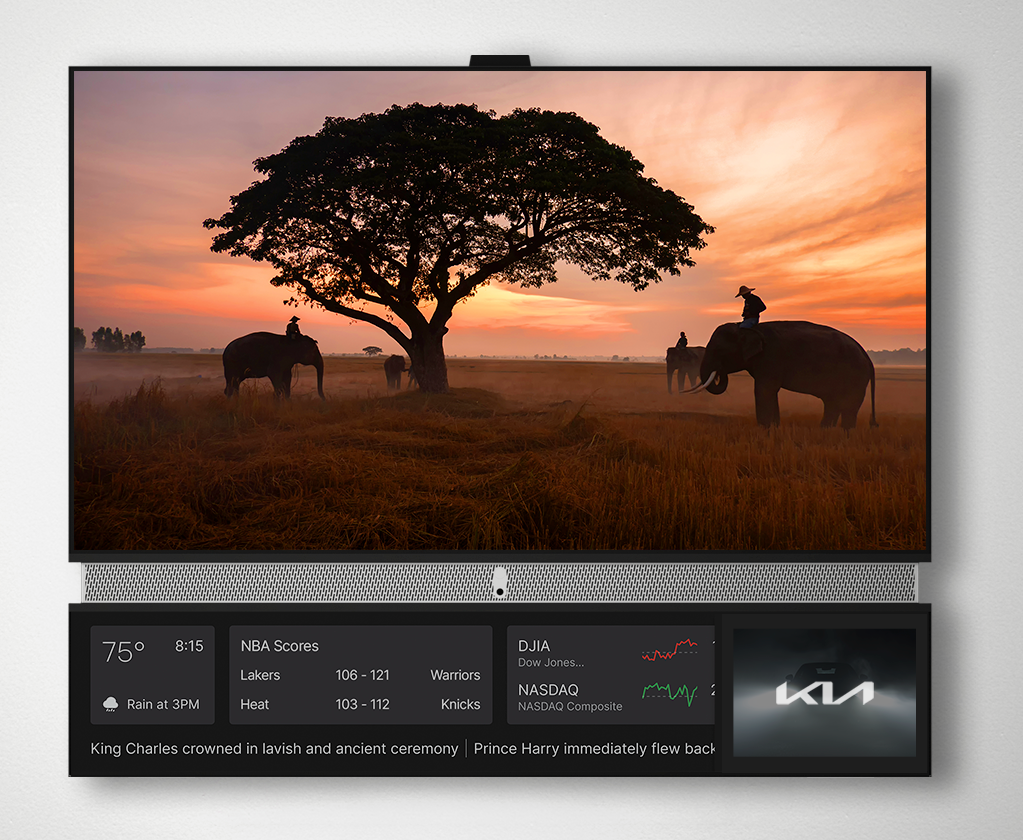Telly, the new hardware startup that is providing U.S. consumers with free smart TVs that are completely supported by advertising, claimed that 250,000 people registered within the first two weeks of launch. In the first 36 hours of launching, Telly said that over 100,000 people registered.
We sat down with Telly founder and CEO Ilya Pozin and chief strategy officer Dallas Lawrence, who revealed to us the new total number of sign-ups. The figure is a clear sign that consumers are willing to cough up their data if it means getting a free TV, which the company claims to each be worth $1,000. Telly’s TV also comes with an Android TV streaming device at no additional cost.
“These are savvy consumers that understand that we’re giving them the smartest TV to get in the market and that we’re just disrupting the traditional way it’s sold,” Pozin told us.
As TechCrunch previously reported, the free giveaway is only possible because of the ads that are displayed on the smaller second screen located below the 55-inch 4K TV. Telly requires the user to give the company detailed info about themselves, such as their name, age, gender, home address and ethnicity, as well as viewing habits and purchasing behaviors.
Of note, Gen Z and Millennial consumers — who are notorious for resisting ad-supported services — made up two-thirds of Telly sign-ups, the company claimed.
“[Gen Z and Millennials] are largely unreachable … 66% of that demographic doesn’t have cable TV. They also don’t watch ad-supported streaming,” Lawrence said. He noted that a lot of younger consumers are “second screen” users — viewers that watch TV while using a secondary device at the same time. Overall, 80% of Americans regularly use a second screen, per Nielsen.
Telly’s smaller second screen doesn’t just display ads but also acts as the control center, allowing users to change channels, adjust the brightness, raise the volume and more — all without having to pause a movie or show. While users can’t turn off the bottom screen, luckily they can control the brightness so it’s not annoying when they watch the main screen in a dark room.
Users can also access third-party apps like Zoom, games and music as well as add widgets like sports scores, weather, stocks and news.
“Ads are a small portion of it … obviously they’re there because they pay for the TV, but the majority of it is dedicated toward enhancing what you’re doing. As you’re using it, you’ll notice that it actually is not distracting,” Pozin said.
The advertisements appear 24/7 in the far right-hand corner. Another ad format is a news ticker that scrolls across the bottom. In addition, the ads are interactive, so users can use their remote to engage with them.
“They’re not only clickable, they’re fully transactional,” Pozin added. “Let’s say you see an ad for Pizza Hut during a sports game, you can actually order a pizza … You’ll actually be able to take your remote and click the ad and engage it and then perform your action on there.”
During our conversation, Pozin disclosed future plans for the product. For instance, Telly will one day be compatible with other connected devices in the home such as security cameras and thermostats. Telly will also continue to roll out software updates and launch new partnerships with third-party apps.
Unlike other hardware companies, Telly won’t release a new model every few years. However, Pozin revealed that the company plans to launch a larger version of the TV that will also be free.
Last week, Telly announced DirecTV as its first partner. DirecTV Stream customers who sign up will receive priority access to the Telly waiting list. In 2023, Telly plans to ship 500,000 free units across the U.S. It will then ship millions more next year.
In order to reserve a free TV, consumers must download Telly’s mobile app, which will ask them to complete a lengthy survey that takes about five or six minutes. The questionnaire asks the respondent if they’re registered to vote, their annual household income, along with very specific questions about what activities they enjoy, such as sports, video games, arts and crafts, cooking and so on. Telly even asks what types of food their household likes to eat, whether it be Italian, Japanese, Chinese or American.
The data collected acts as anonymous insights that Telly uses to serve targeted ads to the consumer. It is also being sold to third parties, such as ad networks, data brokers, marketing providers and media companies.
In most states, ad networks can collect, share and sell large amounts of data without notifying the user. However, Telly argues that it is one of the few companies that ask consumers for permission and are transparent about what data it collects.
Plus, Telly users are actually “compensated for it,” Lawrence said.
If a user doesn’t want Telly to collect and sell their data, the privacy policy states that they can request to delete the data (which the company can deny) and opt out of data sales by completing an online form or sending an email to support@freetelly.com. If the user opts out, they must return the TV to the company.
Lawrence told us that if a user attempts to alter the software — such as using an ad blocker — Telly is able to deactivate the TV.
The privacy policy also refers to the data that Telly doesn’t collect, which includes voice and video recordings. However, since its voice assistant technology, “Hey Telly,” is powered by third parties, these partners “may anonymously store voice commands to make improvements and enhancements to our services,” wrote the document. The company said this is the industry standard with voice assistant technology.
Telly has a built-in camera, which allows users to video chat, experience motion-tracking fitness programs and play arcade games. The camera has a physical shutter built into it, so the user can choose to close the camera. The company said it doesn’t store “images, recordings, or biometric information” on Telly servers.

